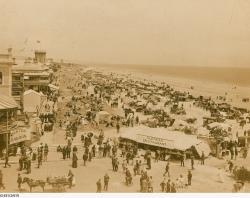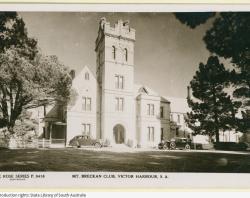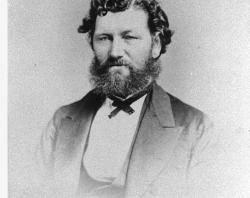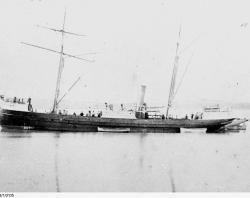
The very wealthy built luxurious summer residences in the hills and on the south coast. Alexander Hay, who had risen from running a general store in Rundle Street to being one of the wealthiest men in South Australia, built a two-storey, 80-room castle designed by well-known Adelaide architect Willian McMinn, on a hill above the little coastal town of Port Victor. Here he entertained lavishly, with colonial governors and a variety of other notable figures as his guests. Chief Justice Samuel Way was a regular visitor at ‘Mount Breckan’ at Christmas. His diaries recorded the boating parties and other activities arranged by the Hay family.
‘… you can drive, go fishing, or sit still and gaze peacefully on one of the most lovely pictures of coast and sea that can be found outside of Sydney Harbour.’ ~ Samuel Way to Sir Henry Parkes, 27 March 1890, SLNSW
Captain George Johnston was a Scottish riverboat captain based at Goolwa. In 1877 he had returned to Scotland to superintend the building of a paddle steamer specially designed to be able to navigate in and out of the Murray Mouth. Incredibly, a year later he sailed the Queen of the South all the way from Scotland to Goolwa. On New Years Day 1879, with a full load of passengers, Captain Johnston brought the Queen of the South out of the Murray Mouth, and steamed around Granite Island.
The first European settlers had quickly adapted to the warm southern Decembers. They took advantage of the climate to turn much of their northern hemisphere Christmas festivities into active outdoor pursuits. However, the traditional Christmas Day roast with trimmings remained largely unchanged despite the summer heat. In the mid-nineteenth century, newer fashionable European practices were added, such as the sending of greeting cards.
Santa Claus or Father Christmas emerged to replace St Nicholas and although carol singing has remained popular, the musical style has changed, and new Christmas songs have emerged. A distinctive local flavour has developed around the festivities including picnics at the beach, walks in the park, and backyard cricket. Celebratory cuisine has changed to include cold meats, prawns, salads, cherries and pavlova.
But for many, even today, an Australian Christmas is not complete without Christmas pudding, mince pies and trifle.
Story written by Anthony Laube, Coordinator Collection Development























